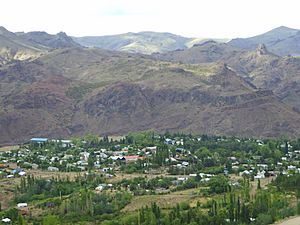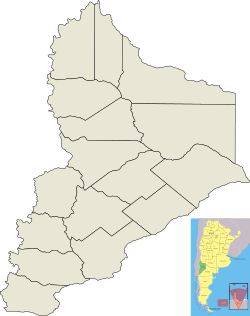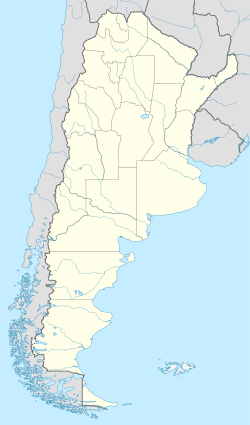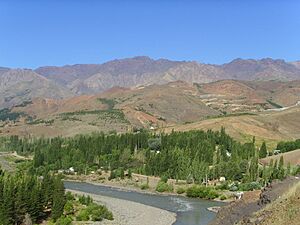Andacollo, Neuquén facts for kids
Quick facts for kids
Andacollo
|
|
|---|---|
 |
|
| Country | |
| Province | Neuquén Province |
| Department | Minas Department |
| Founded | October 26, 1939 |
| Elevation | 1,113 m (3,652 ft) |
| Population
(2010 census [INDEC])
|
|
| • Total | 2,653 |
| Time zone | UTC−3 (ART) |
| CPA Base |
Q 8353
|
| Area code(s) | +54 02945 |
| Climate | Csb |
| Website | www.andacollo.gob.ar |
Andacollo is a town in Argentina, located in the Neuquén Province. It's the main town in the Minas Department. It sits in a valley surrounded by the Wind Mountain Range. After Chos Malal, it's the second-biggest town in the northern part of the province.
Andacollo started as a mining town in the late 1800s, attracting people mainly from Chile. Even though mining isn't as big as it used to be, it's still important for the town's economy. The town also helps nearby farms and ranches, where people raise animals and plant trees.
Contents
What's in a Name?
Long ago, this place was called Cañada del Durazno. This means "Peaches' Narrow Pass" in Spanish.
Later, in the late 1800s, gold miners from Chile arrived. They renamed the town Andacollo in 1910. This name honored their hometown of Andacollo in Chile.
The name Andacollo might come from Kichwa words. Anta and coya could mean "Queen of Metal" or "Copper Mine." Some locals also say it means "woman with cat eyes," but this isn't certain.
A Look Back in Time
Early Settlers and Gold
The land around Andacollo was first home to the Pehuenche people. In 1882, gold seekers from Chile set up a camp here. This camp became a base for their search for gold in the mountains. Many people moved to the Minas Department because of this. These miners were called Pirquineros. They often carried a picture of the Virgin of Andacollo with them.
Town's Growth and Official Recognition
From 1910 to about 1923, the town celebrated its anniversary in February. In 1932, the first local group, called the developing committee, was started. The government officially recognized the town's name on October 26, 1939. This date has been the town's anniversary ever since.
Mining Boom and Changes
The gold mining business grew a lot between the 1920s and the 1950s. But by the late 1940s, gold prices around the world fell. This, along with problems in farming, caused many people to leave. By the 1960s, locals had to find new ways to make a living.
Today, Andacollo is the main town for the Minas Department. It also provides services for the farms and communities nearby.
Where is Andacollo?
Andacollo is in the northern part of the Neuquén Province. It sits where the Varvaco river and the Líleo river meet. These two rivers form the upper Neuquén River. The town is in a valley surrounded by the Wind Mountain Range.
Climate and Weather
The town is about 1,113 meters (3,652 feet) above sea level. It has a Mediterranean feel, which means it's often sunny. It's also semiarid and mildly cold. Winds mostly blow from the northwest. Sometimes, cold winds come from the south and east.
Getting There
You can reach Andacollo by Provincial Route 43 from Chos Malal. You can also use Provincial Routes 6 and 38 from the south.
- It's about 60 kilometers (37 miles) from Chos Malal.
- It's about 460 kilometers (286 miles) from Neuquén, the province capital.
- It's about 1,587 kilometers (986 miles) from Buenos Aires.
How Many People Live Here?
In 2010, the Argentine census counted 2,653 people living in Andacollo. This was a small increase from 2,627 people in 2001. The town's population grew a lot during the 1900s. It went from 531 residents in 1970 to 1,250 in 1980. By 1991, there were 1,641 people.
What Does Andacollo Do?
Andacollo is the second-largest town in the northern Neuquén Province. It's important as a service center for the people living in the Minas Department.
Main Industries
- Mining: Mining is still a key part of the town's economy. People here mainly dig for gold, copper, and granite.
- Farming: In the areas around the town, people focus on agriculture. They also raise animals like goats (called capra), sheep (called ovis), and cattle.
Fun Things to See and Do
Andacollo might not be a typical tourist spot. But it's a great starting point for trips around the Minas Department.
Natural Wonders
- Nearby Towns: You can visit Huinganco, which is known as Neuquén's garden.
- Volcano Adventures: The Domuyo volcano is 4,709 meters (15,449 feet) tall. It's a popular place for trekking because it's the highest peak in Patagonia.
- Lakes for Fun: The Epulafquen lagoons are perfect for camping, hiking, and recreational fishing. You can often catch rainbow trout here.
Town Life and History
Andacollo also lets you see what small-town life is like in northern Neuquén.
- Miners' Bar: The old miners' bar looks almost the same as it did in the 1960s. Miners used to meet here until 1990. This building is made of stone, adobe, and a cardboard roof. It's now a cultural landmark, showing the town's mining past.
- Cultural Events: You can often find cultural events happening at the amphitheater on Jaime de Nevares street. There's also a craftsmen fair where local handmade products are sold.
See also
 In Spanish: Andacollo (Neuquén) para niños
In Spanish: Andacollo (Neuquén) para niños




